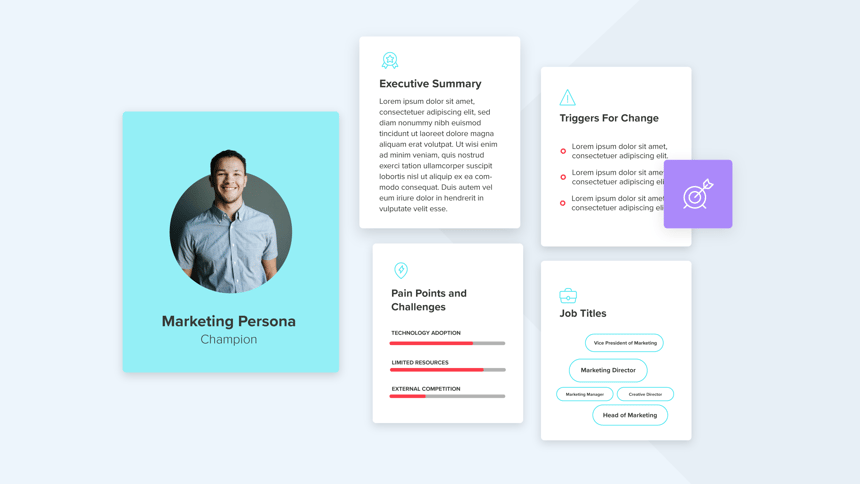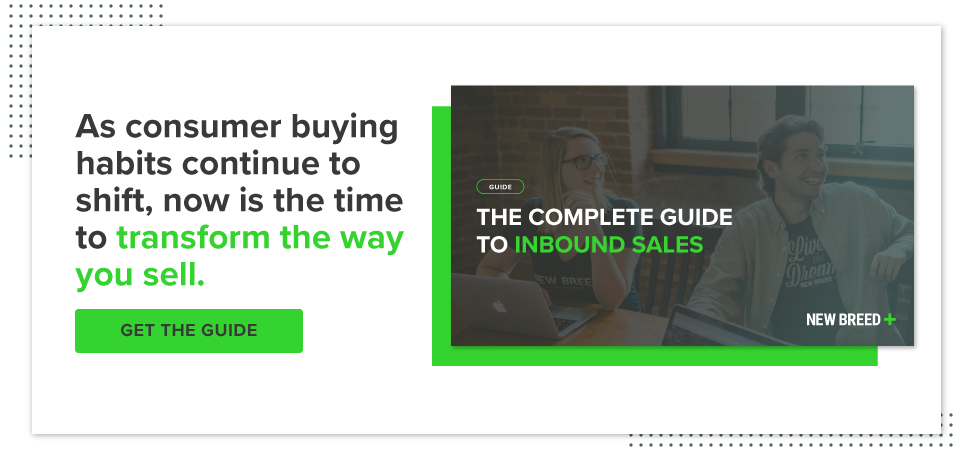
Buyer personas are semi-fictional representations of your ideal customer. They’re an essential foundational component of any inbound marketing strategy.
When they’re well-made, buyer personas can be a powerful tool for marketing-and-sales alignment and help you ensure you’re focusing your marketing and sales efforts on the people who will benefit the most from your product or service.
To learn more about how to create buyer personas, I sat down with Senior Growth Strategist Nick Frigo and Client Experience Lead Karin Krisher who help New Breed’s clients with persona creation. Here are four steps they said you need to follow when creating buyer personas.
1. Identify the Purpose of Your Buyer Personas
You should not be building buyer personas for the sake of having them. They should be created in order to be leveraged.
“If you’re not creating segments on your website, if you’re not tailoring your forms to them, if you’re not providing your salespeople with insights that come from knowing who the persona is, — why bother?” Karin says. “Understanding the purpose of having them and how you will use them is the most important thing to do before developing buyer personas.”
So, start by defining how you intend to use your buyer personas. Are you looking to better define your marketing audience so you can create a better content strategy? Does your sales team need a resource to help them identify who to seek out when prospecting? Are you trying to align your company around who you should be marketing and selling to?
In addition to creating buyer personas, you should also be establishing ideal customer profiles (ICPs), to ensure fit. While buyer personas depict the type of people your company would like to work with, ICPs represent the type of companies they work at and include firmographic information like company size, industry and annual revenue.
Finally, determine if you’re building your personas based on your current customer base or trying to create something more speculative based on a market your company is trying to expand into.
Generally, companies will have two to three personas based on their historical customer data and one built on where they want to grow.
How you go about collecting information will differ for existing buyers and hypothetical buyers.
2. Create Your Template
Before starting to research your buyer personas and collecting information about them, you should build out a template documenting everything you need to know.
What will a manifested persona look like for your company? What information do your marketing, sales and service teams need to use your personas for their intended purpose?
Some commonly included sections are:
- Role in company: What level of authority does your buyer persona have and what department do they work in? For example, your buyer persona may be an HR manager, a sales rep or a finance director.
- Role in buying process: Is this persona the decision-maker? How did they get involved in the buying process? Were they brought in by a boss to do technical analysis? Did they experience a need, found your company organically and are now trying to gain buy-in from their executive team?
“Their role in the buying process is often really different from their role in the organization,” Nick says.
- Job title: What are common job titles this persona holds? This information can be useful for ad targeting or prospecting.
- Day-to-day responsibilities: What does a day in the life of your buyer persona look like? What are their goals? What are they accountable for? How are they being measured by their bosses?
“You need to understand what their day-to-day responsibilities are beyond just the challenge that you’re specifically trying to solve,” Nick says. “What companies often do is instead of understanding their day-to-day from a job point of view, they write about their day-to-day from a person point of view.”
Characteristics like age, marital status and interests are important for B2C advertising, but for B2B they generally shouldn’t be included. Unless you can use that information for ad targeting or segmentation, it shouldn’t be included in your buyer persona.
- Pain points and challenges: What are the struggles your buyer persona is facing? What gets in the way of them exceeding their goals? What annoyances do they experience every day?
- Value propositions: How can your company and your product or service help solve for your persona’s pain points?
A common mistake when writing these value propositions is focus on the strengths of your product or service at a high-level instead of refining them to align with the needs of the specific persona.
“[Your value propositions] should answer ‘how does [my product or service] make this person’s day-to-day better? How does it enable them to do things that they weren’t able to do before? It should be really specific to that persona,” Nick says.
“If you can’t think of things that would support whatever you’ve decided their day-to-day challenges are, then you should reconsider whether or not they should be a persona,” Karin adds.
- Online resources and channels: Where does this persona turn to get information? Are there any publications they regularly read or social media channels they have a strong presence on?
- Triggers for change: Triggers for change are the reasons that a need for your product appears for a persona. It can be events like a company reaching a new growth stage, someone getting a promotion or a contract ending with another vendor.
These won’t necessarily always need to be included in personas, but they can be particularly useful for companies that leverage ABM. These triggers help you understand where demand appears and why, which can be used to inform your content strategy and outreach tactics for this persona.
Additionally, you should consult with your sales team directly about what sections they think should be included in your personas.
Nick recommends asking them “if you could prick your buyer personas with a truth serum and ask them three questions about themselves, what would you ask so you can gain more sales leverage?”
These factors will differ company to company but should definitely be included in your personas.
3. Conduct Interviews and Research
Once your template is built out, the next step is to fill it in with information. Some of the necessary information will require research, but a lot of it can be gathered from speaking to employees at your company.
“The people who are actually on the front lines with your customers are the ones who really have that color and texture into what [the people your personas represent] are really needing, what the things in the sales process are that make their eyes light up,” Nick says.
Interview your sales reps about the trends they notice among prospects and ask them for the information you need to fill in on your personas. Some good questions to use as a starting point are:
- Do they normally first talk to decision-makers or someone else within a company?
- What kinds of prospects do they have the easiest time selling to?
- What are common objections they encounter?
- How do prospects respond to your company’s value propositions?
- Do prospects already use an equivalent of your product? Why or why not?
You should also interview your product and service teams about the customers they serve. They’re going to be able to provide the best insight into what types of prospects make the best customers and how your company is fulfilling their needs.
Ask them questions like:
- How is your product or service being used by customers?
- What aspects of your offering provide the most benefits to customers?
- What challenges do customers have when working with your company?
- Who within a customer’s company does your team work with? Is it a consultant or end-user? Is it someone different from who your sales team worked with during the sales process?
If possible, you should also try to interview some of your current customers and ask them the same types of questions you asked your team to gain their perspective.
If you’re building personas based on your historical or current customer base, you should also conduct a contact analysis on your database to verify the information you’ve gathered. Using your CRM, look at all of your customers and identify trends for things like job titles, industries and how they became involved in the buying process.
4. Build Your Buyer Personas
Take all the information you’ve gathered and put it into your template to create a finalized persona.
“Whatever you build as a template needs to be usable for everyone within your organization,” Karin says. “In terms of format, that means whatever is most accessible for everyone.”
Your personas can be a slide deck, a PDF, a shared Google Drive file or whatever else works best for your company.
In addition to ensuring your personas are in an easily accessible format, you also need to make sure there’s a shared understanding of what the information they contain means. Consider creating a glossary explaining what the different sections represent or creating documentation around how the personas can be leveraged.
The Takeaway
In order to create the strongest buyer personas possible, it’s best to bring in an outside consultant.
Personas are resources for multiple teams throughout your company and in order to be accurate, they require feedback from multiple stakeholders too. Assigning the responsibility to create them with just one team increases the chances that they’ll overly reflect that single team’s point of view.
“It’s impossible for people who have a vested interest in something to prioritize things that aren’t their vested interest. So, you need someone to externalize all the priorities,” Nick says.
Consulting with an expert can help expose some of those assumptions in order to create a more well-rounded depiction of your target customer.
“The teams internally that you work with might have slightly different ideas of what your growth priorities are, they might have a slightly different idea of who you’re selling to, they might even have a different approach to your messaging strategy and how you’re talking about your products and services,” Nick says.
Getting all stakeholders at your company aligned on how you tell your story and speak to your audience can give you a one-up over competitors — and creating accurate buyer personas will help your marketing team attract leads that your sales team can convert into customers that your company wants to work with.
Quinn Kanner
Quinn is a writer and copyeditor whose work ranges from journalism to travel writing to inbound marketing content.





